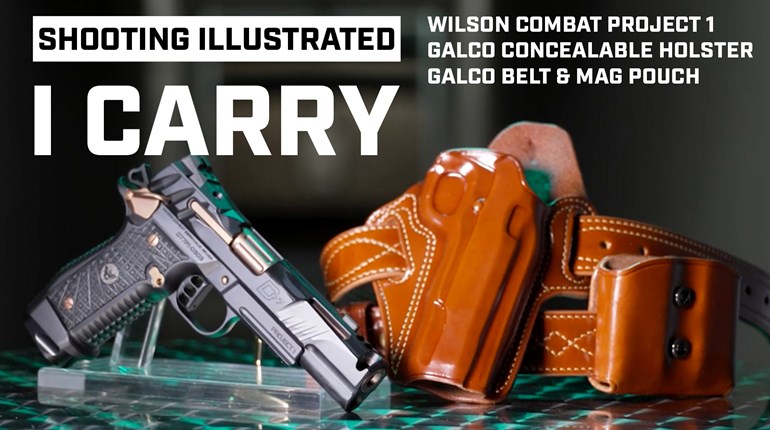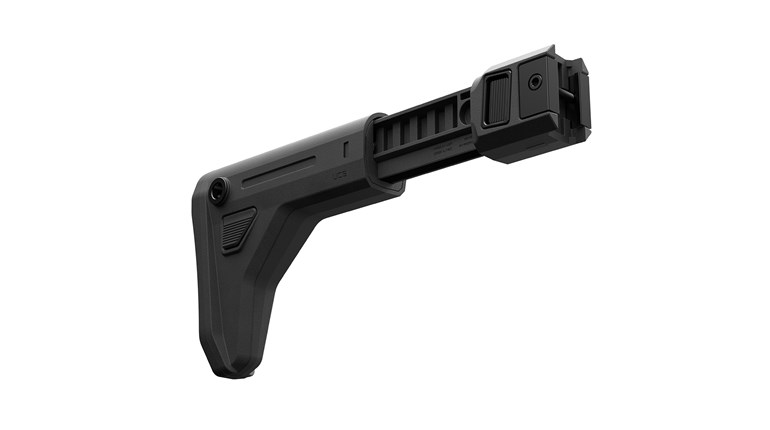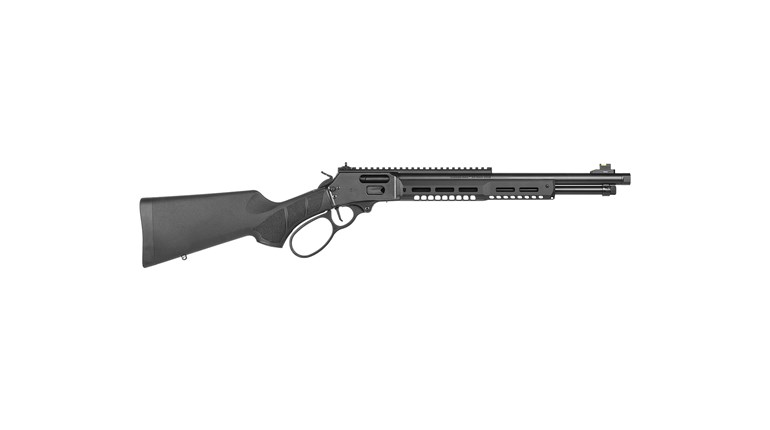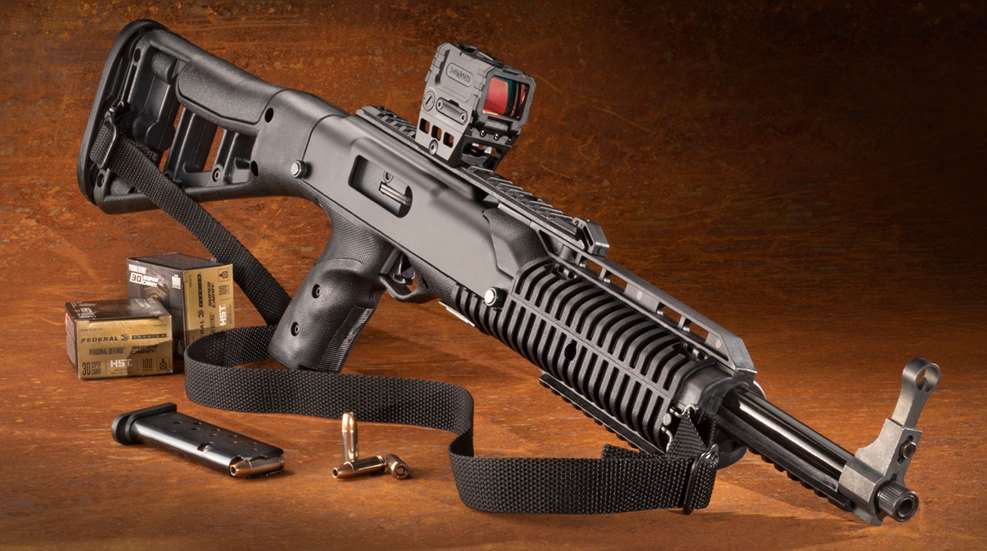
While people think Sir Edmund Hillary responded “Because it’s there” to the question of why he climbed Mount Everest, it was actually an earlier climber, George Mallory, who made that infamous statement. That’s neither here nor there, but it is germane to the creation of a carbine platform for the 30 Super Carry round, one previously thought of—if thought of at all in its relative infancy—as exclusively for handguns. Hi-Point Firearms has expanded its line of affordable carbines to include the Model 3095 chambered in 30 Super Carry, and the rationale behind this line extension uses logic similar to Mallory’s. Why make a carbine chambered in 30 Super Carry? Because no one else has.
Now, I know what you’re going to say. “But, Jay, the 30 Super Carry was developed as a way to get more capacity in handguns optimal for concealed carry than traditional 9 mm pistols without sacrificing too much in the way of muzzle energy.” OK, maybe not, but I’m guessing what you’re really thinking isn’t something we can print. Yes, the idea behind the 30 Super Carry round was to get performance levels similar to the standard 9 mm round in a cartridge that would allow greater capacity in micro-9 mm double-stack pistols like the SIG Sauer P365 or Smith & Wesson Shield Plus.
And?

The .45-70 Gov’t round was optimized for stopping large game out of a break-action rifle, and Bond Arms makes a freakin’ single-shot derringer chambered in it. There are other derringers in rifle rounds like 5.56 NATO and 7.62x39 mm. Heck, I’ve got a Smith & Wesson J-frame made out of scandium and titanium, weighing a whopping 12 ounces, chambered in .357 Mag. You know, the round that, when it was introduced in the 1930s, was deemed too powerful for most to handle, to the point it was offered only in a large-frame revolver? Point is, there’s a long and storied history of putting rounds that were designed for a certain type of firearm into a completely different—sometimes the exact “opposite”—type of gun. In this particular case, yes, Hi-Point has gone the reverse direction and put a handgun round into a carbine. I reiterate: And?
The Enduring Popularity of Hi-Point Firearms
Hi-Point’s line of economic, blowback-operated carbines has been around since the late 1990s, when the company launched its 995. The ubiquitous 9 mm chambering was later joined by .45 ACP, then .40 S&W, .380 ACP and 10 mm—the .380 ACP providing a clue as to why the company might decide to offer a 30 Super Carry version now. Firearms chambered in .380 ACP are generally compact or smaller handguns. When it comes to rifles in .380 ACP, there’s the Hi-Point 3895 and … well, I can’t find anything else. There might be a boutique carbine or two out there, but none that show up in the first couple pages of a Google search, and in this day and age, that means there just aren’t any. It’s not surprising, then, that Hi-Point would entertain the idea of another pistol-caliber carbine chambered for a round like the 30 Super Carry. Such a product would expand the carbine line, add another firearm in 30 Super Carry and be the first to market. Why not?
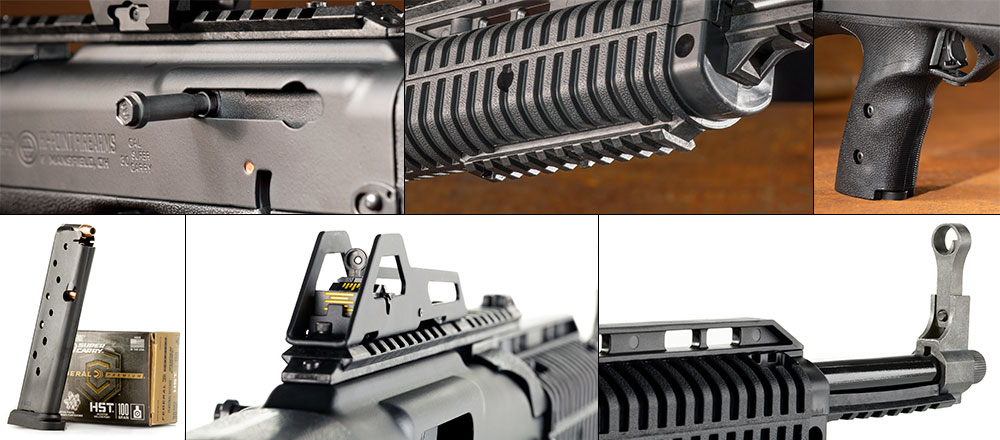
It’s the design of the 30 Super Carry, too, that makes it a decent candidate for the carbine treatment, actually. At an impressive 45,000 psi, it’s a high-pressure round that will certainly make the most out of a longer barrel. In fact, that’s often the line of thinking behind rounds like the .22 Mag. and the 5.7x28 mm—in a handgun, those rounds are … less-than-optimal, but we often hear that longer barrels wring more performance out of them. Why, then, is it shocking that a company might apply that same thinking to the 30 Super Carry? Yes, Federal designed it for handguns, but why not drop it into a carbine and see what happens? It’s touted as having less recoil in a handgun than 9 mm with similar muzzle energy; why, then, would that be a bad thing in a carbine? Easier to shoot than 9 mm with similar terminal performance? Heavens! Who could possibly want such a thing, besides basically everyone? Now, yes, the 9 mm carbine offers a larger magazine (20-round variants are available) at a lower price-per-round; while Hi-Point was tight-lipped about magazines with capacity greater than 10 for the 3095, I would be shocked if such units didn’t appear relatively soon should the carbine achieve any sort of commercial success.
So Why Make A 30 Super Carbine?
All of this, though, dances around the proverbial elephant in the room: Why would someone opt for a carbine in 30 Super Carry with the same—or, actually, less, given the 20-round magazines offered for the 9 mm Hi-Point carbine—capacity than a functionally identical carbine in the more available 9 mm? As much as it pains me, we’re going to have to do some math here. In the pages of Shooting Illustrated, we have reviewed the Smith & Wesson Shield Plus in both 9 mm and 30 Super Carry. Out of the Shield Plus’s 3.1-inch barrel, a 100-grain 30 Super Carry FMJ reached a muzzle velocity of 1,175 fps, translating into 307 ft.-lbs. of muzzle energy. Out of the same-length barrel in the 9 mm pistol, a 115-grain projectile achieved a muzzle velocity of 1,080 fps, for a muzzle energy of 298 ft.-lbs. Not the same-weight projectile? The 115-grain 30 Super Carry reached a nearly identical 1,060 fps, which results in a whole 9 ft.-lbs. less muzzle energy than the 9 mm. Bottom line is the 30 Super Carry is hitting energy numbers ridiculously close to that of 9 mm, but with less felt recoil. Does that make a difference? To some people, it does.

Comparing apples to, well, slightly different apples, we tested a different carbine in 9 mm and discovered that a 115-grain projectile reached a velocity of 1,307 fps, for 436 ft.-lbs. of muzzle energy. Out of the Hi-Point carbine, a 115-grain 30 Super Carry bullet hit 1,324 fps for 448 ft.-lbs. of muzzle energy. Now, 12 ft.-lbs. isn’t a huge increase, but it is notable that the 30 Super Carry delivered more energy than 9 mm out of a carbine. As for felt recoil, it’s pretty comparable to the same-weight carbine in 9 mm, which is to say not all that noticeable. It was interesting to note the difference in felt recoil between handguns and carbines: I reviewed a Smith & Wesson Shield Plus in 30 Super Carry that had, in my experience, less recoil (but more pop) than its 9 mm counterpart, while the carbines were pretty much indistinguishable. Again, though, the felt recoil of 9 mm or 30 Super Carry in a carbine is minimal; if the Model 3095 is used for home defense, that light recoil with decent muzzle energy is a great choice.

Being able to better control a home-defense carbine without sacrificing performance is never a bad thing. Certainly, 30 Super Carry is more expensive than 9 mm, but as a dedicated home-defense firearm? It’s going to require less practice ammo to maintain proficiency than a pistol, so the cost differential really isn’t as significant as a handgun you carry everyday and should (ideally) be practicing and training with regularly. And, if you’ve happened to have invested in 30 Super Carry for your handgun? Well, there’s now a carbine available. In fact, as of the time this article was written, the Hi-Point Model 3095 is the only carbine on the market chambered in 30 Super Carry. You might say Hi-Point is the world-leader in 30 Super Carry carbines.
Now, sure, the 3095 isn’t exactly what anyone would call aesthetically pleasing. Then again, Hi-Point’s carbines (and pistols) aren’t expected to be objets d’art, but functional, budget-conscious firearms. If the, ahem, utilitarian vibe is a little too brutalist for your liking, fear not. Aftermarket replacement stocks for the Model 995 carbine should fit the Model 3095, as the only differences between the two are the bolt, barrel and magazines. High Tower Armory, for example, makes a bullpup conversion for the Model 995 that’s available in a variety of colors and gives more of a Tavor-like feel to the Hi-Point. Or, you could just live with the standard carbine and spend that extra cash on a red-dot sight and extra ammo. That’s one of the beautiful things about the Model 3095: at an MSRP of $369 and an off-the-shelf price almost certainly closer to $300, it is the least expensive firearm chambered in 30 Super Carry on the market. There is quite simply no more economical way to get into the 30 Super Carry game than the Model 3095.

There’s another, more practical reason to think about the Model 3095: Ammunition compatibility. If you’ve adopted one of the everyday carry pistols built around Federal’s 30 Super Carry, having a carbine that takes the same ammo as your pistol adds utility. It’s a time-honored concept, from Colt SAA revolvers in .44-40 WCF that matched the Winchester lever-action to the 1911s and Thompsons in World War II to the myriad striker-fired 9 mm pistols and PCCs today. Hi-Point’s Model 3095 brings the same compatibility to the 30 Super Carry, which, as we’ve noted in these pages, is one of those “not-9 mm” calibers that might just be available in times of shortage. Hedging against periods of scarcity, especially given what we’ve seen in just the past few years, is a smart idea, especially if you’re keeping an identical manual-of-arms between the two calibers. The Model 3095 even has a barrel threaded to the standard 1/2x28 tpi, so if you have a sound suppressor for a 9 mm firearm, it can work on the 30 Super Carry carbine as well.
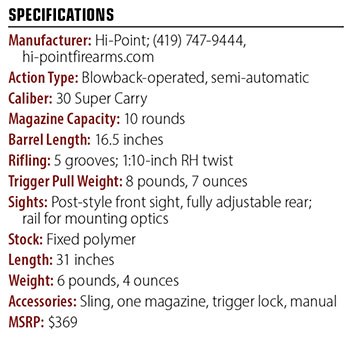 On the range, there were a handful of interesting things to note. As we’ve discovered in other semi-automatic firearms, it’s often necessary to test a pretty wide variety of ammunition to see what a particular gun likes—and doesn’t like. In the case of the Model 3095, it wasn’t a big fan of the Remington/UMC 100-grain FMJ ammo. Multiple stovepipes were experienced with the Remington, and only with the Remington. Both 115-grain CCI/Blazer and 100-grain American Eagle FMJ rounds functioned without incident in the Hi-Point, as did Federal Premium HST 100-grain JHP ammo. Accuracy-wise, groups mostly hovered around 2 inches at 50 yards, which would be less-than-ideal for a precision bolt-action rifle, but certainly fine for home defense (unsurprisingly, the defense-oriented hollowpoint rounds offered the best accuracy results). As a second note, the difference in point-of-impact between the 100-grain projectiles and the heavier 115-grain ones was noticeable at 50 yards, to the point of needing a quick adjustment in elevation in the EOTech Vudu 1-6X scope I’d added for testing.
On the range, there were a handful of interesting things to note. As we’ve discovered in other semi-automatic firearms, it’s often necessary to test a pretty wide variety of ammunition to see what a particular gun likes—and doesn’t like. In the case of the Model 3095, it wasn’t a big fan of the Remington/UMC 100-grain FMJ ammo. Multiple stovepipes were experienced with the Remington, and only with the Remington. Both 115-grain CCI/Blazer and 100-grain American Eagle FMJ rounds functioned without incident in the Hi-Point, as did Federal Premium HST 100-grain JHP ammo. Accuracy-wise, groups mostly hovered around 2 inches at 50 yards, which would be less-than-ideal for a precision bolt-action rifle, but certainly fine for home defense (unsurprisingly, the defense-oriented hollowpoint rounds offered the best accuracy results). As a second note, the difference in point-of-impact between the 100-grain projectiles and the heavier 115-grain ones was noticeable at 50 yards, to the point of needing a quick adjustment in elevation in the EOTech Vudu 1-6X scope I’d added for testing.
Other than the Model 3095’s mystifying dislike of the Remington ammo, there were no other problems on the range. Having put one of Hi-Point’s C-9 pistol through a 2,000-round torture test for our website, I’m quite familiar with the loading process for Hi-Point magazines, and there’s no discernible difference between the 30 Super Carry and 9 mm versions. Make sure the magazines are properly seated in the carbine, run the bolt handle like you mean it and the Model 3095 is ready to go. Offhand shooting and benchrest shooting offered little noticeable difference in recoil, although there was one slightly painful realization: While Hi-Point carbines don’t have an adjustable stock, the design still has points that can catch errant facial hair—something I thought I only had to deal with when shooting standard AR-15-style carbines. In total, though, some 260 rounds were sent through the 3095, with only the stovepipes with a single brand of ammo to mention.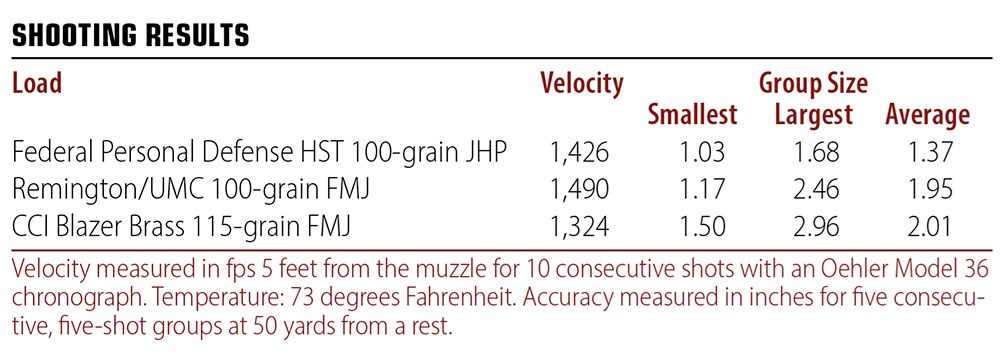
What’s the bottom line, then? If you’ve been curious about the new 30 Super Carry round, this is currently the least-expensive way to try it out. Certainly, if you’re already invested in Federal’s whiz-bang pistol round, the Model 3095 provides a platform for a home-defense carbine in that same caliber. If you’ve had any experience with Hi-Point’s 995 carbine in 9 mm, the 3095 is essentially identical, so there’s a shallow learning curve. From a preparedness standpoint, it makes sense to have a backup caliber when your primary gets scarce, and even more so if the backup maintains an identical manual-of-arms and levels of performance. The Hi-Point Model 3095 is yet another option, which is always a good thing. In this case, it’s another option in the growing array of selections for Federal’s 30 Super Carry round, which adds even more utility for home and self-defense.












